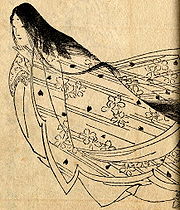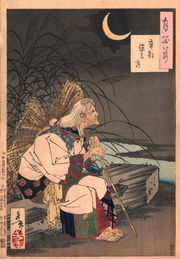
Ono no Komachi
Encyclopedia


Japanese people
The are an ethnic group originating in the Japanese archipelago and are the predominant ethnic group of Japan. Worldwide, approximately 130 million people are of Japanese descent; of these, approximately 127 million are residents of Japan. People of Japanese ancestry who live in other countries...
waka
Waka (poetry)
Waka or Yamato uta is a genre of classical Japanese verse and one of the major genres of Japanese literature...
poet
Poet
A poet is a person who writes poetry. A poet's work can be literal, meaning that his work is derived from a specific event, or metaphorical, meaning that his work can take on many meanings and forms. Poets have existed since antiquity, in nearly all languages, and have produced works that vary...
, one of the Rokkasen—the Six best Waka poets
Six best Waka poets
The Six Immortals of Poetry were famous poets of Waka in the early Heian period of Japanese history. They were:* Henjo* Ariwara no Narihira* Fun'ya no Yasuhide* Kisen* Ono no Komachi* Ōtomo Kuronushi...
of the early Heian period
Heian period
The is the last division of classical Japanese history, running from 794 to 1185. The period is named after the capital city of Heian-kyō, or modern Kyōto. It is the period in Japanese history when Buddhism, Taoism and other Chinese influences were at their height...
. She was noted as a rare beauty; Komachi is a symbol of a beautiful woman in Japan
Japan
Japan is an island nation in East Asia. Located in the Pacific Ocean, it lies to the east of the Sea of Japan, China, North Korea, South Korea and Russia, stretching from the Sea of Okhotsk in the north to the East China Sea and Taiwan in the south...
. She also figures among the Thirty-six Poetry Immortals
Thirty-six Poetry Immortals
The Thirty-six Poetry Immortals are a group of Japanese poets of the Nara, Asuka and Heian periods selected by Fujiwara no Kintō as exemplars of Japanese poetic ability. There are five female poets among them...
.
Life and legends
The place of Komachi's birth and death is uncertain. According to one tradition, she was born in what is now Akita PrefectureAkita Prefecture
is a prefecture of Japan located in the Tōhoku Region of northern Honshu, the main island of Japan. The capital is the city of Akita.- History :The area of Akita has been created from the ancient provinces of Dewa and Mutsu....
, daughter of Yoshisada, "Lord of Dewa". Her social status is also uncertain. She may have been a low-ranking consort or a lady-in-waiting of an emperor, possibly Emperor Ninmyō (r. 833-850).
As a poet, Komachi specialized in erotic love themes, expressed in complex poems. Most of her waka
Waka (poetry)
Waka or Yamato uta is a genre of classical Japanese verse and one of the major genres of Japanese literature...
are about anxiety, solitude or passionate love. She is the only female poet referred to in the preface of the Kokin Wakashū, which describes her style as "containing naivety in old style but also delicacy".
There are legends about Komachi in love. The most famous is a story about her relationship with Fukakusa no Shosho, a high-ranking courtier. Komachi promised that if he visited her continuously for a hundred nights, then she would become his lover. Fukakusa no Shosho visited her every night, but failed once towards the end. Despairing, he fell ill and subsequently died. When Komachi learned of his death she was overcome with sadness.
Legacy
Komachi sometimes features in later period literature, including five NohNoh
, or - derived from the Sino-Japanese word for "skill" or "talent" - is a major form of classical Japanese musical drama that has been performed since the 14th century. Many characters are masked, with men playing male and female roles. Traditionally, a Noh "performance day" lasts all day and...
plays: Sotoba Komachi, Sekidera Komachi, Oomu Komachi, Sōshi Arai Komachi and Kayoi Komachi. These works tend to focus on her talent for waka and her love affairs and the vanity of a life spent indulging in romantic liaisons. Komachi's old age is also frequently portrayed: when she has lost her beauty, has been abandoned by her former lovers, and now regrets her life, wandering around as a lonely beggar woman — albeit still appreciated by young admirers of her poetry. This is a fictional description influenced by Buddhist thought and there may be no factual resemblance between this portrait and the historical reality.
In honor of her, the Akita Shinkansen
Akita Shinkansen
The is a Mini-shinkansen high-speed rail line in Japan. Serving the Kantō and Tōhoku Regions of the country, it links Tokyo and Akita in Akita prefecture with direct service. From Tokyo to Morioka in Iwate prefecture, it operates on the Tōhoku Shinkansen tracks. From there to Ōmagari, it uses the...
is nicknamed Komachi. Also a variety of rice, Akita Komachi bears her name. One of her 31-syllable poems was chosen by Fujiwara no Teika
Fujiwara no Teika
Fujiwara no Teika , also known as Fujiwara no Sadaie or Sada-ie, was a Japanese poet, critic, calligrapher, novelist, anthologist, scribe, and scholar of the late Heian and early Kamakura periods...
as an entry in the very popular anthology Hyakunin Isshu
Hyakunin Isshu
is a traditional anthology style of compiling Japanese waka poetry where each contributor writes one poem for the anthology. Literally, it translates to "one hundred people, one poem [each]"...
.
Sotoba Komachi ("Komachi on the stupa
Stupa
A stupa is a mound-like structure containing Buddhist relics, typically the remains of Buddha, used by Buddhists as a place of worship....
") is one of the Noh plays reworked from originals by Mishima Yukio for the modern theater. The basic plot (the age-worn former beauty encounters a young poet and relates some of her life story, which causes him to fall in love with her, with fatal results) is retained, but the action has been transferred to a public park, with flashbacks to the salons and ballrooms of the Meiji
Meiji
Meiji may refer to:* Meiji Restoration, the revolution that ushered in the Meiji period* Meiji period - the period in Japanese history when the Meiji Emperor reigned...
-era Japan. English translation by Donald Keene
Donald Keene
Donald Lawrence Keene is a Japanologist, scholar, teacher, writer, translator and interpreter of Japanese literature and culture. Keene was University Professor Emeritus and Shincho Professor Emeritus of Japanese Literature at Columbia University, where he taught for over fifty years...
was published in 1967.
Ono no Komachi is also the subject of a modern one-woman play, Call Me Komachi, produced by Lemon Tart Productions, written by Christie Nieman, directed by Miki Oikawa and starring Kaori Hamamoto. Call Me Komachi enjoyed successful seasons at various venues in Australia from 2003 to 2006. The play compares and parallels the lives of traditional Geisha with contemporary Japanese schoolgirls in "paid dating", known as enjo kōsai
Enjo kosai
means "compensated dating" and is a practice which originated in Japan where older men give money and/or luxury gifts to attractive women for their companionship and, possibly, for sexual favors. The female participants range from primarily school-aged girls to housewives. A common misconception is...
.
The play "Three Poets" by playwright "Romulus Linney" includes a one act story about the poet Komachi.

